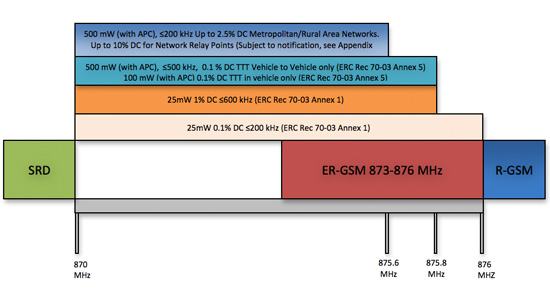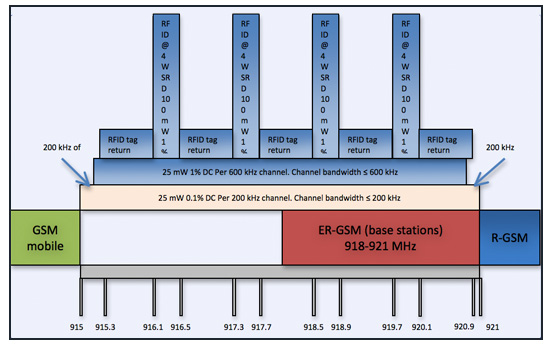Short range devices with a long reach
As the seemingly insatiable appetite for spectrum for wireless broadband continues apace, supported by the European Union’s spectrum policy programme which calls for 1200 MHz to be made available, we take a contrasting look at why some of our more moderate spectrum users are also ripe for growth. A wide range of highly valuable uses of spectrum are to be found squeezed into a few relatively narrow bands operating as (typically unlicensed) Short Range Devices (SRD). These devices have a huge significance in our daily lives, whether as assistance for people with a hearing impairment, or bringing down the costs of supermarket goods, or as part of making an intruder alarm system affordable, to give just three examples.
Our Newsletter article of June 2012 outlined how the ECC is working to improve the efficiency of these bands and widen the possibilities for accessing them. This is based on applying a step-by-step evidence-based process for enabling more generic conditions to be applied to wider spectrum bands than before, instead of slicing the available frequencies into narrow bandwidths for niche applications. Our Newsletter in January 2011 highlighted how one sector, RFID (Radio Frequency Identification Devices) can bring huge cost savings and efficiencies to logistics in the commercial and public sectors. That article also announced the date of a major workshop on short-range devices which was hosted by the ECC and held in the early summer of that year.
Now, a major milestone, driven by demand
Now the ECC is reaching a major milestone in the development and management of frequencies in the favoured range just below 1 GHz for a wide variety of SRD applications with the creation of a new roadmap which paves the way for a major upgrade of 19 MHz of spectrum. At present the range 863 to 870 MHz is used extensively for SRDs. However, these ranges are filling up quickly and a lot of new developments are anticipated, as set out in ECC Report 182 (Survey about the use of the frequency band 863-870 MHz) and by ETSIi in a set of System Reference Documents. This includes rising spectrum demands for generic SRD, UHF RFID, Home Automation & Sub Metering, Automotive SRD, Smart Meters and Smart Grids, Metropolitan Mesh Machine Networks (M3N) applications, Alarm and Social Alarm systems, and Assistive Listening Devices (including hearing aids). In addition to capacity constraints, the bandwidth of the existing plans is limiting to developing applications, e.g. a wider bandwidth for individual RFID devices will improve their performance and function. With machine mesh networks, the required bandwidth of the systems would not fit into the existing narrow bandwidths that are available.
Against this background, we need to take account of two significant considerations. Firstly, in the American continent nearby frequencies (902 to 928 MHz) are allocated to ISMii, which is a convenient basis for using SRDs, and therefore a lot of equipment is being developed to operate in this range. For Europe, as part of the ITU-R Region 1, no ISM band was identified at the World Administrative Radio Conference (WARC-79) in 1979 in this part of the spectrum. This new SRD harmonisation measure (together with the DSIiii harmonisation effort about ten years ago) is for practical purposes a Europe-specific review of that decision made 34 years ago. Secondly, there are two significant adjacent frequency ranges which are seriously under-utilised in many countries: namely 870 - 876 MHz, and 915 - 921 MHz; these are frequencies which had been prepared for use by private mobile radio systems, but that development has seen very little take-up.
ECC instruments and conclusions
ECC Report 200 gives the background and conclusions to a comprehensive set of coexistence studies in these under-utilised UHF bands in Europe. Some of these used the ECC’s SEAMCAT analysis tool, developed and maintained by the ECO in Copenhagen. The related ECC Report 189 prepared by the ECC’s SRD Maintenance Group, uses these conclusions to define recommended regulatory parameters for SRDs. This report is currently out for public consultation, and when finalised it is expected to form part of the ECC’s key regulatory document on SRDs, Recommendation 70-03. ECC Report 200 looks partly at the compatibility issues between different sorts of SRDs to investigate whether their use of the band is compatible with existing services. However, the major part of the report recognises that although under-utilised for Professional Mobile Radio (PMR), there are significant existing governmental services with access to part of the new frequencies in several countries which would need protection in the future at the discretion of the relevant national administrations. The review included an audit of these existing and planned uses, which revealed not only some of the military tactical systems as known about, but also some new uses such as remote control of unmanned aircraft (UAV). Some other countries anticipate needing to use the spectrum in some specific locations for an extension of the existing GSM-R bands. The studies in the ECC have covered this utilisation to provide a solution for spectrum sharing with GSM-R.
870-876 MHz band plan:
915-921 MHz band plan:
ECC Report 200 also describes the use of network access points/network relay points forming part of metropolitan area ‘mesh’ networks for utilities or other applications for the purpose of data acquisition for example.
Network relay points can be operated by various providers in the same metropolitan area and are recommended to be notified to the administration as part of a general authorisation framework. This means that it is not intended to limit the number of M/RAN (Metropolitan/Rural Area Network) in a given area a priori and that the principles as set out in CEPT Report 44 should apply, such as equal access to the spectrum, on a shared basis, in a technical and application-neutral manner. Further technical measures are not recommended at the moment but may be subject to review, should traffic overload situations materialise in the future.
This particular approach provides a good example of the ECC's use of ‘soft harmonisation’, where existing services remain protected to the extent that national administrations deem it necessary, yet providing the opportunity for the harmonised development of new services in the majority of European countries. The success of ERC Recommendation 70-03 owes much to its ‘soft harmonisation’ approach, which is quicker to set up than a more rigid, centralised harmonisation process, where the measures needed to deal with important but limited incumbent interest can block or delay the process at the European level.
Thomas Weber, ECO Expert in Frequency Management and
Mark Thomas, Director of the ECO
i The European Telecommunication Standards Institute published five system reference documents: Generic SRD, RFID, Home Automation & Sub Metering and Automotive SRD, TR 102-649-2; Smart Meters and Smart Grids, TR 102 886; Metropolitan Mesh Machine Networks (M3N) applications, TR 103 055; Alarm and Social Alarm systems, TR 103 056; and Assistive Listening Devices, TR 102 791.
ii Industrial, Scientific and Medical uses.
iii Detailed Spectrum Investigation, a three-phase thorough review of the European plan for allocation of frequencies.


